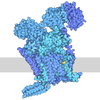+ データを開く
データを開く
- 基本情報
基本情報
| 登録情報 | データベース: PDB / ID: 7pfp | |||||||||||||||
|---|---|---|---|---|---|---|---|---|---|---|---|---|---|---|---|---|
| タイトル | Full-length cryo-EM structure of the native human uromodulin (UMOD)/Tamm-Horsfall protein (THP) filament | |||||||||||||||
 要素 要素 | Uromodulin | |||||||||||||||
 キーワード キーワード | ANTIMICROBIAL PROTEIN / EGF DOMAIN / DECOY MODULE / BETA-HAIRPIN / D10C DOMAIN / ZP MODULE / ZP DOMAIN / ZP-N DOMAIN / ZP-C DOMAIN / INTERDOMAIN LINKER / EXTRACELLULAR MATRIX / GLYCOPROTEIN / N-GLYCAN / STRUCTURAL PROTEIN / PROTEIN FILAMENT / PROTEIN POLYMERIZATION | |||||||||||||||
| 機能・相同性 |  機能・相同性情報 機能・相同性情報citric acid secretion / metanephric thick ascending limb development / metanephric distal convoluted tubule development / connective tissue replacement / protein transport into plasma membrane raft / Asparagine N-linked glycosylation / organ or tissue specific immune response / collecting duct development / urea transmembrane transport / metanephric ascending thin limb development ...citric acid secretion / metanephric thick ascending limb development / metanephric distal convoluted tubule development / connective tissue replacement / protein transport into plasma membrane raft / Asparagine N-linked glycosylation / organ or tissue specific immune response / collecting duct development / urea transmembrane transport / metanephric ascending thin limb development / micturition / protein localization to vacuole / regulation of protein transport / intracellular chloride ion homeostasis / juxtaglomerular apparatus development / antibacterial innate immune response / renal urate salt excretion / urate transport / renal sodium ion absorption / glomerular filtration / neutrophil migration / intracellular phosphate ion homeostasis / response to water deprivation / potassium ion homeostasis / intracellular sodium ion homeostasis / regulation of urine volume / endoplasmic reticulum organization / heterophilic cell-cell adhesion via plasma membrane cell adhesion molecules / IgG binding / extrinsic component of membrane / ciliary membrane / leukocyte cell-cell adhesion / cellular response to unfolded protein / multicellular organismal response to stress / cellular defense response / renal water homeostasis / side of membrane / tumor necrosis factor-mediated signaling pathway / : / ERAD pathway / RNA splicing / apoptotic signaling pathway / regulation of blood pressure / autophagy / lipid metabolic process / Golgi lumen / intracellular calcium ion homeostasis / spindle pole / basolateral plasma membrane / defense response to Gram-negative bacterium / response to lipopolysaccharide / cilium / apical plasma membrane / inflammatory response / response to xenobiotic stimulus / negative regulation of cell population proliferation / calcium ion binding / cell surface / endoplasmic reticulum / extracellular space / extracellular exosome / membrane 類似検索 - 分子機能 | |||||||||||||||
| 生物種 |  Homo sapiens (ヒト) Homo sapiens (ヒト) | |||||||||||||||
| 手法 | 電子顕微鏡法 / 単粒子再構成法 / クライオ電子顕微鏡法 / 解像度: 6.1 Å | |||||||||||||||
 データ登録者 データ登録者 | Jovine, L. / Xu, C. / Stsiapanava, A. / Carroni, M. / Tunyasuvunakool, K. / Jumper, J. / Wu, B. | |||||||||||||||
| 資金援助 |  スウェーデン, 4件 スウェーデン, 4件
| |||||||||||||||
 引用 引用 |  ジャーナル: Nat Struct Mol Biol / 年: 2022 ジャーナル: Nat Struct Mol Biol / 年: 2022タイトル: Structure of the decoy module of human glycoprotein 2 and uromodulin and its interaction with bacterial adhesin FimH. 著者: Alena Stsiapanava / Chenrui Xu / Shunsuke Nishio / Ling Han / Nao Yamakawa / Marta Carroni / Kathryn Tunyasuvunakool / John Jumper / Daniele de Sanctis / Bin Wu / Luca Jovine /     要旨: Glycoprotein 2 (GP2) and uromodulin (UMOD) filaments protect against gastrointestinal and urinary tract infections by acting as decoys for bacterial fimbrial lectin FimH. By combining AlphaFold2 ...Glycoprotein 2 (GP2) and uromodulin (UMOD) filaments protect against gastrointestinal and urinary tract infections by acting as decoys for bacterial fimbrial lectin FimH. By combining AlphaFold2 predictions with X-ray crystallography and cryo-EM, we show that these proteins contain a bipartite decoy module whose new fold presents the high-mannose glycan recognized by FimH. The structure rationalizes UMOD mutations associated with kidney diseases and visualizes a key epitope implicated in cast nephropathy. #1: ジャーナル: Nat Cell Biol / 年: 2002 タイトル: The ZP domain is a conserved module for polymerization of extracellular proteins. 著者: Luca Jovine / Huayu Qi / Zev Williams / Eveline Litscher / Paul M Wassarman /  要旨: Many eukaryotic extracellular proteins share a sequence of unknown function, called the zona pellucida (ZP) domain. Among these proteins are the mammalian sperm receptors ZP2 and ZP3, non-mammalian ...Many eukaryotic extracellular proteins share a sequence of unknown function, called the zona pellucida (ZP) domain. Among these proteins are the mammalian sperm receptors ZP2 and ZP3, non-mammalian egg coat proteins, Tamm-Horsfall protein (THP), glycoprotein-2 (GP-2), alpha- and beta-tectorins, transforming growth factor (TGF)-beta receptor III and endoglin, DMBT-1 (deleted in malignant brain tumour-1), NompA (no-mechanoreceptor-potential-A), Dumpy and cuticlin-1 (refs 1,2). Here, we report that the ZP domain of ZP2, ZP3 and THP is responsible for polymerization of these proteins into filaments of similar supramolecular structure. Most ZP domain proteins are synthesized as precursors with carboxy-terminal transmembrane domains or glycosyl phosphatidylinositol (GPI) anchors. Our results demonstrate that the C-terminal transmembrane domain and short cytoplasmic tail of ZP2 and ZP3 are not required for secretion, but are essential for assembly. Finally, we suggest a molecular basis for dominant human hearing disorders caused by point mutations within the ZP domain of alpha-tectorin. #2: ジャーナル: Am J Kidney Dis / 年: 2003 タイトル: Tamm-Horsfall glycoprotein: biology and clinical relevance. 著者: Franca Serafini-Cessi / Nadia Malagolini / Daniela Cavallone /  要旨: Tamm-Horsfall glycoprotein (THP) is the most abundant urinary protein in mammals. Urinary excretion occurs by proteolytic cleavage of the large ectodomain of the glycosyl phosphatidylinositol- ...Tamm-Horsfall glycoprotein (THP) is the most abundant urinary protein in mammals. Urinary excretion occurs by proteolytic cleavage of the large ectodomain of the glycosyl phosphatidylinositol-anchored counterpart exposed at the luminal cell surface of the thick ascending limb of Henle's loop. We describe the physical-chemical structure of human THP and its biosynthesis and interaction with other proteins and leukocytes. The clinical relevance of THP reported here includes: (1) involvement in the pathogenesis of cast nephropathy, urolithiasis, and tubulointerstitial nephritis; (2) abnormalities in urinary excretion in renal diseases; and (3) the recent finding that familial juvenile hyperuricemic nephropathy and autosomal dominant medullary cystic kidney disease 2 arise from mutations of the THP gene. We critically examine the literature on the physiological role and mechanism(s) that promote urinary excretion of THP. Some lines of research deal with the in vitro immunoregulatory activity of THP, termed uromodulin when isolated from urine of pregnant women. However, an immunoregulatory function in vivo has not yet been established. In the most recent literature, there is renewed interest in the capacity of urinary THP to compete efficiently with urothelial cell receptors, such as uroplakins, in adhering to type 1 fimbriated Escherichia coli. This property supports the notion that abundant THP excretion in urine is promoted in the host by selective pressure to obtain an efficient defense against urinary tract infections caused by uropathogenic bacteria. #3: ジャーナル: Proc Natl Acad Sci U S A / 年: 2004 タイトル: A duplicated motif controls assembly of zona pellucida domain proteins. 著者: Luca Jovine / Huayu Qi / Zev Williams / Eveline S Litscher / Paul M Wassarman /  要旨: Many secreted eukaryotic glycoproteins that play fundamental roles in development, hearing, immunity, and cancer polymerize into filaments and extracellular matrices through zona pellucida (ZP) ...Many secreted eukaryotic glycoproteins that play fundamental roles in development, hearing, immunity, and cancer polymerize into filaments and extracellular matrices through zona pellucida (ZP) domains. ZP domain proteins are synthesized as precursors containing C-terminal propeptides that are cleaved at conserved sites. However, the consequences of this processing and the mechanism by which nascent proteins assemble are unclear. By microinjection of mutated DNA constructs into growing oocytes and mammalian cell transfection, we have identified a conserved duplicated motif [EHP (external hydrophobic patch)/IHP (internal hydrophobic patch)] regulating the assembly of mouse ZP proteins. Whereas the transmembrane domain (TMD) of ZP3 can be functionally replaced by an unrelated TMD, mutations in either EHP or IHP do not hinder secretion of full-length ZP3 but completely abolish its assembly. Because mutants truncated before the TMD are not processed, we conclude that the conserved TMD of mammalian ZP proteins does not engage them in specific interactions but is essential for C-terminal processing. Cleavage of ZP precursors results in loss of the EHP, thereby activating secreted polypeptides to assemble by using the IHP within the ZP domain. Taken together, these findings suggest a general mechanism for assembly of ZP domain proteins. #4: ジャーナル: FEBS Lett / 年: 2004 タイトル: Identification and characterization of D8C, a novel domain present in liver-specific LZP, uromodulin and glycoprotein 2, mutated in familial juvenile hyperuricaemic nephropathy. 著者: Huirong Yang / Chaoqun Wu / Shouyuan Zhao / Jinhu Guo /  要旨: Present work reported a novel domain--D8C (domain with conserved eight cysteines in liver-specific ZP domain-containing protein, glycoprotein 2 (GP-2) and uromodulin (UMOD)), present in liver- ...Present work reported a novel domain--D8C (domain with conserved eight cysteines in liver-specific ZP domain-containing protein, glycoprotein 2 (GP-2) and uromodulin (UMOD)), present in liver-specific LZP, UMOD, GP-2 and some uncharacterized proteins, most of which are membrane proteins, extracellular proteins or nuclear membrane proteins. D8C contains eight well-conserved cysteine residues, which were predicted to form four pairs of disulfide bridges. D8C is composed mainly of beta-strands. Mutation in the D8C at Cys217 in human UMOD is associated with familial juvenile hyperuricaemic nephropathy, which might be due to the disruption of the disulfide bridge. Identification of D8C would further the understandings of related proteins. #5: ジャーナル: Mol Biol Cell / 年: 2009 タイトル: Analysis of uromodulin polymerization provides new insights into the mechanisms regulating ZP domain-mediated protein assembly. 著者: Céline Schaeffer / Sara Santambrogio / Simone Perucca / Giorgio Casari / Luca Rampoldi /  要旨: Uromodulin is the most abundant protein secreted in urine, in which it is found as a high-molecular-weight polymer. Polymerization occurs via its zona pellucida (ZP) domain, a conserved module shared ...Uromodulin is the most abundant protein secreted in urine, in which it is found as a high-molecular-weight polymer. Polymerization occurs via its zona pellucida (ZP) domain, a conserved module shared by many extracellular eukaryotic proteins that are able to assemble into matrices. In this work, we identified two motifs in uromodulin, mapping in the linker region of the ZP domain and in between protein cleavage and glycosylphosphatidylinositol (GPI)-anchoring sites, which regulate its polymerization. Indeed, mutations in either module led to premature intracellular polymerization of a soluble uromodulin isoform, demonstrating the inhibitory role of these motifs for ZP domain-mediated protein assembly. Proteolytic cleavage separating the external motif from the mature monomer is necessary to release the inhibitory function and allow protein polymerization. Moreover, we report absent or abnormal assembly into filaments of GPI-anchored uromodulin mutated in either the internal or the external motif. This effect is due to altered processing on the plasma membrane, demonstrating that the presence of the two modules has not only an inhibitory function but also can positively regulate protein polymerization. Our data expand previous knowledge on the control of ZP domain function and suggest a common mechanism regulating polymerization of ZP domain proteins. #6: ジャーナル: Elife / 年: 2015 タイトル: The serine protease hepsin mediates urinary secretion and polymerisation of Zona Pellucida domain protein uromodulin. 著者: Martina Brunati / Simone Perucca / Ling Han / Angela Cattaneo / Francesco Consolato / Annapaola Andolfo / Céline Schaeffer / Eric Olinger / Jianhao Peng / Sara Santambrogio / Romain Perrier ...著者: Martina Brunati / Simone Perucca / Ling Han / Angela Cattaneo / Francesco Consolato / Annapaola Andolfo / Céline Schaeffer / Eric Olinger / Jianhao Peng / Sara Santambrogio / Romain Perrier / Shuo Li / Marcel Bokhove / Angela Bachi / Edith Hummler / Olivier Devuyst / Qingyu Wu / Luca Jovine / Luca Rampoldi /     要旨: Uromodulin is the most abundant protein in the urine. It is exclusively produced by renal epithelial cells and it plays key roles in kidney function and disease. Uromodulin mainly exerts its function ...Uromodulin is the most abundant protein in the urine. It is exclusively produced by renal epithelial cells and it plays key roles in kidney function and disease. Uromodulin mainly exerts its function as an extracellular matrix whose assembly depends on a conserved, specific proteolytic cleavage leading to conformational activation of a Zona Pellucida (ZP) polymerisation domain. Through a comprehensive approach, including extensive characterisation of uromodulin processing in cellular models and in specific knock-out mice, we demonstrate that the membrane-bound serine protease hepsin is the enzyme responsible for the physiological cleavage of uromodulin. Our findings define a key aspect of uromodulin biology and identify the first in vivo substrate of hepsin. The identification of hepsin as the first protease involved in the release of a ZP domain protein is likely relevant for other members of this protein family, including several extracellular proteins, as egg coat proteins and inner ear tectorins. #7:  ジャーナル: Proc Natl Acad Sci U S A / 年: 2016 ジャーナル: Proc Natl Acad Sci U S A / 年: 2016タイトル: A structured interdomain linker directs self-polymerization of human uromodulin. 著者: Marcel Bokhove / Kaoru Nishimura / Martina Brunati / Ling Han / Daniele de Sanctis / Luca Rampoldi / Luca Jovine /    要旨: Uromodulin (UMOD)/Tamm-Horsfall protein, the most abundant human urinary protein, plays a key role in chronic kidney diseases and is a promising therapeutic target for hypertension. Via its bipartite ...Uromodulin (UMOD)/Tamm-Horsfall protein, the most abundant human urinary protein, plays a key role in chronic kidney diseases and is a promising therapeutic target for hypertension. Via its bipartite zona pellucida module (ZP-N/ZP-C), UMOD forms extracellular filaments that regulate kidney electrolyte balance and innate immunity, as well as protect against renal stones. Moreover, salt-dependent aggregation of UMOD filaments in the urine generates a soluble molecular net that captures uropathogenic bacteria and facilitates their clearance. Despite the functional importance of its homopolymers, no structural information is available on UMOD and how it self-assembles into filaments. Here, we report the crystal structures of polymerization regions of human UMOD and mouse ZP2, an essential sperm receptor protein that is structurally related to UMOD but forms heteropolymers. The structure of UMOD reveals that an extensive hydrophobic interface mediates ZP-N domain homodimerization. This arrangement is required for filament formation and is directed by an ordered ZP-N/ZP-C linker that is not observed in ZP2 but is conserved in the sequence of deafness/Crohn's disease-associated homopolymeric glycoproteins α-tectorin (TECTA) and glycoprotein 2 (GP2). Our data provide an example of how interdomain linker plasticity can modulate the function of structurally similar multidomain proteins. Moreover, the architecture of UMOD rationalizes numerous pathogenic mutations in both UMOD and TECTA genes. #8: ジャーナル: Curr Top Dev Biol / 年: 2018 タイトル: Structure of Zona Pellucida Module Proteins. 著者: Marcel Bokhove / Luca Jovine /  要旨: The egg coat, an extracellular matrix made up of glycoprotein filaments, plays a key role in animal fertilization by acting as a gatekeeper for sperm. Egg coat components polymerize using a common ...The egg coat, an extracellular matrix made up of glycoprotein filaments, plays a key role in animal fertilization by acting as a gatekeeper for sperm. Egg coat components polymerize using a common zona pellucida (ZP) "domain" module that consists of two related immunoglobulin-like domains, called ZP-N and ZP-C. The ZP module has also been recognized in a large number of other secreted proteins with different biological functions, whose mutations are linked to severe human diseases. During the last decade, tremendous progress has been made toward understanding the atomic architecture of the ZP module and the structural basis of its polymerization. Moreover, sperm-binding regions at the N-terminus of mollusk and mammalian egg coat subunits were found to consist of domain repeats that also adopt a ZP-N fold. This discovery revealed an unexpected link between invertebrate and vertebrate fertilization and led to the first structure of an egg coat-sperm protein recognition complex. In this review we summarize these exciting findings, discuss their functional implications, and outline future challenges that must be addressed in order to develop a comprehensive view of this family of biomedically important extracellular molecules. #9:  ジャーナル: EMBO J / 年: 2020 ジャーナル: EMBO J / 年: 2020タイトル: Cryo-EM structure of native human uromodulin, a zona pellucida module polymer. 著者: Alena Stsiapanava / Chenrui Xu / Martina Brunati / Sara Zamora-Caballero / Céline Schaeffer / Marcel Bokhove / Ling Han / Hans Hebert / Marta Carroni / Shigeki Yasumasu / Luca Rampoldi / Bin ...著者: Alena Stsiapanava / Chenrui Xu / Martina Brunati / Sara Zamora-Caballero / Céline Schaeffer / Marcel Bokhove / Ling Han / Hans Hebert / Marta Carroni / Shigeki Yasumasu / Luca Rampoldi / Bin Wu / Luca Jovine /     要旨: Assembly of extracellular filaments and matrices mediating fundamental biological processes such as morphogenesis, hearing, fertilization, and antibacterial defense is driven by a ubiquitous ...Assembly of extracellular filaments and matrices mediating fundamental biological processes such as morphogenesis, hearing, fertilization, and antibacterial defense is driven by a ubiquitous polymerization module known as zona pellucida (ZP) "domain". Despite the conservation of this element from hydra to humans, no detailed information is available on the filamentous conformation of any ZP module protein. Here, we report a cryo-electron microscopy study of uromodulin (UMOD)/Tamm-Horsfall protein, the most abundant protein in human urine and an archetypal ZP module-containing molecule, in its mature homopolymeric state. UMOD forms a one-start helix with an unprecedented 180-degree twist between subunits enfolded by interdomain linkers that have completely reorganized as a result of propeptide dissociation. Lateral interaction between filaments in the urine generates sheets exposing a checkerboard of binding sites to capture uropathogenic bacteria, and UMOD-based models of heteromeric vertebrate egg coat filaments identify a common sperm-binding region at the interface between subunits. #10: ジャーナル: Nature / 年: 2021 タイトル: Highly accurate protein structure prediction with AlphaFold. 著者: John Jumper / Richard Evans / Alexander Pritzel / Tim Green / Michael Figurnov / Olaf Ronneberger / Kathryn Tunyasuvunakool / Russ Bates / Augustin Žídek / Anna Potapenko / Alex Bridgland / ...著者: John Jumper / Richard Evans / Alexander Pritzel / Tim Green / Michael Figurnov / Olaf Ronneberger / Kathryn Tunyasuvunakool / Russ Bates / Augustin Žídek / Anna Potapenko / Alex Bridgland / Clemens Meyer / Simon A A Kohl / Andrew J Ballard / Andrew Cowie / Bernardino Romera-Paredes / Stanislav Nikolov / Rishub Jain / Jonas Adler / Trevor Back / Stig Petersen / David Reiman / Ellen Clancy / Michal Zielinski / Martin Steinegger / Michalina Pacholska / Tamas Berghammer / Sebastian Bodenstein / David Silver / Oriol Vinyals / Andrew W Senior / Koray Kavukcuoglu / Pushmeet Kohli / Demis Hassabis /   要旨: Proteins are essential to life, and understanding their structure can facilitate a mechanistic understanding of their function. Through an enormous experimental effort, the structures of around ...Proteins are essential to life, and understanding their structure can facilitate a mechanistic understanding of their function. Through an enormous experimental effort, the structures of around 100,000 unique proteins have been determined, but this represents a small fraction of the billions of known protein sequences. Structural coverage is bottlenecked by the months to years of painstaking effort required to determine a single protein structure. Accurate computational approaches are needed to address this gap and to enable large-scale structural bioinformatics. Predicting the three-dimensional structure that a protein will adopt based solely on its amino acid sequence-the structure prediction component of the 'protein folding problem'-has been an important open research problem for more than 50 years. Despite recent progress, existing methods fall far short of atomic accuracy, especially when no homologous structure is available. Here we provide the first computational method that can regularly predict protein structures with atomic accuracy even in cases in which no similar structure is known. We validated an entirely redesigned version of our neural network-based model, AlphaFold, in the challenging 14th Critical Assessment of protein Structure Prediction (CASP14), demonstrating accuracy competitive with experimental structures in a majority of cases and greatly outperforming other methods. Underpinning the latest version of AlphaFold is a novel machine learning approach that incorporates physical and biological knowledge about protein structure, leveraging multi-sequence alignments, into the design of the deep learning algorithm. | |||||||||||||||
| 履歴 |
|
- 構造の表示
構造の表示
| ムービー |
 ムービービューア ムービービューア |
|---|---|
| 構造ビューア | 分子:  Molmil Molmil Jmol/JSmol Jmol/JSmol |
- ダウンロードとリンク
ダウンロードとリンク
- ダウンロード
ダウンロード
| PDBx/mmCIF形式 |  7pfp.cif.gz 7pfp.cif.gz | 242.5 KB | 表示 |  PDBx/mmCIF形式 PDBx/mmCIF形式 |
|---|---|---|---|---|
| PDB形式 |  pdb7pfp.ent.gz pdb7pfp.ent.gz | 188.4 KB | 表示 |  PDB形式 PDB形式 |
| PDBx/mmJSON形式 |  7pfp.json.gz 7pfp.json.gz | ツリー表示 |  PDBx/mmJSON形式 PDBx/mmJSON形式 | |
| その他 |  その他のダウンロード その他のダウンロード |
-検証レポート
| 文書・要旨 |  7pfp_validation.pdf.gz 7pfp_validation.pdf.gz | 1.9 MB | 表示 |  wwPDB検証レポート wwPDB検証レポート |
|---|---|---|---|---|
| 文書・詳細版 |  7pfp_full_validation.pdf.gz 7pfp_full_validation.pdf.gz | 2 MB | 表示 | |
| XML形式データ |  7pfp_validation.xml.gz 7pfp_validation.xml.gz | 40.1 KB | 表示 | |
| CIF形式データ |  7pfp_validation.cif.gz 7pfp_validation.cif.gz | 61.3 KB | 表示 | |
| アーカイブディレクトリ |  https://data.pdbj.org/pub/pdb/validation_reports/pf/7pfp https://data.pdbj.org/pub/pdb/validation_reports/pf/7pfp ftp://data.pdbj.org/pub/pdb/validation_reports/pf/7pfp ftp://data.pdbj.org/pub/pdb/validation_reports/pf/7pfp | HTTPS FTP |
-関連構造データ
- リンク
リンク
- 集合体
集合体
| 登録構造単位 | 
| |||||||||||||||||||||||||||||||||||||||||||||||||||||||||||||||||||||||||||||||||||||||||||||||||||||||||||||||||||||
|---|---|---|---|---|---|---|---|---|---|---|---|---|---|---|---|---|---|---|---|---|---|---|---|---|---|---|---|---|---|---|---|---|---|---|---|---|---|---|---|---|---|---|---|---|---|---|---|---|---|---|---|---|---|---|---|---|---|---|---|---|---|---|---|---|---|---|---|---|---|---|---|---|---|---|---|---|---|---|---|---|---|---|---|---|---|---|---|---|---|---|---|---|---|---|---|---|---|---|---|---|---|---|---|---|---|---|---|---|---|---|---|---|---|---|---|---|---|---|
| 1 |
| |||||||||||||||||||||||||||||||||||||||||||||||||||||||||||||||||||||||||||||||||||||||||||||||||||||||||||||||||||||
| 非結晶学的対称性 (NCS) | NCSドメイン:
NCSドメイン領域:
|
 ムービー
ムービー コントローラー
コントローラー



 UCSF Chimera
UCSF Chimera

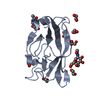
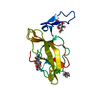
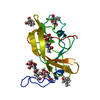



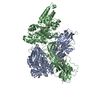


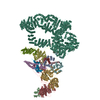




 PDBj
PDBj